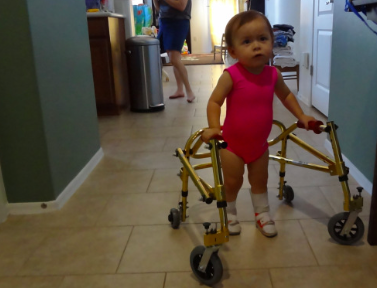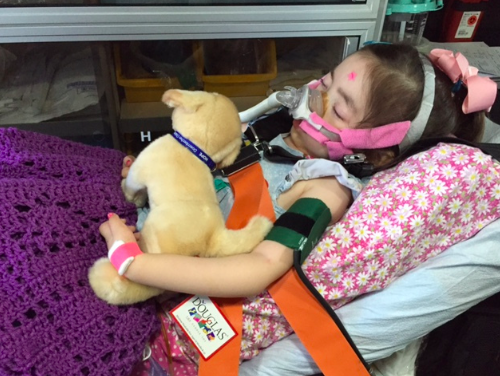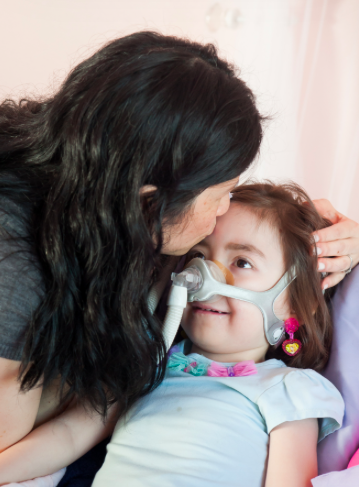By: Michelle Moon
Before my daughter Julianna was born, I knew as much about CMT as the average neurologist, which is to say I knew very little. During residency, I met a patient with CMT who was a rock climber. His hand muscles were atrophied, but he spent his weekends scaling the Colorado Rockies. I also knew a medical student with CMT. He stood for hours on rounds and took the stairs like the rest of us. The people I knew with CMT were resilient and gave me hope. I thought that, with enough determination, CMT could be overcome.
When I found out my daughter had CMT, I learned how very wrong I was.
When Julianna was 18 months old, she still wasn’t close to walking. As a neurologist, I knew there were only a few things that would cause motor delay in an otherwise healthy child. CMT was on that list.

Like most neuropathies, CMT affects the longest nerves in our body first. This is why problems are initially noticed in the feet. Then it goes to the legs, hands and arms. If it’s severe, it weakens the muscles that help us breathe and swallow. This is the most feared complication and the endpoint of all severe neuromuscular diseases.
I knew all that, I had witnessed it in others, and yet I was still surprised by the many ways CMT assaulted Julianna and our family. Paralyzed vocal cords, wicked scoliosis, a dislocated left hip, right diaphragm paralysis. These were just some of the things that CMT did to my daughter. But I was most unprepared for its impact on her breathing.
“Stupid, Evil CMT”
Breathing is the most visible of our vital functions, and it should be as effortless as our heartbeat. It’s hard to watch someone struggle for breath when you know they are fighting with strength they don’t have. Especially when it’s your child.
Her little chest, rising and falling. Her eyes, wide and scared. The shake of her head and a look of despair when she sees that it’s time for the tube again: down her nose, into her throat. I wish I could run away, but she wants me to hold her hand. I can’t breathe for her, but I can do this. I can stand by her while she is tortured. Is this what drowning feels like? Stupid, evil CMT.
This is what I experienced every time Julianna was in the hospital, for weeks on end.

This Isn’t Supposed to Happen
Every doctor has seen and heard things they wish they could forget. The look on a father’s face as he paced the room and rocked his dying child, the sound a mother makes when she realizes her child is gone. You bury these memories deep, because they’re just too much.
Four years ago, it was me rocking and holding my dying child. She was still tethered to her breathing machine, so I didn’t pace around her lovely princess room. I couldn’t have anyway, because my energy was spent, first in the wail that rose out of me when I realized she was really dying, then into the tears that held past, present and future sorrow. I tried to squeeze a lifetime’s worth of a mother’s love into an hour. It was all I could do.
As a neurologist, I was in the best position to give Julianna everything she needed. I got the right doctors and argued successfully with insurance companies. I was organized, proactive, thorough and determined. We fought with ferocity and desperation for our perfect little girl but came up short. CMT beat us. No, it crushed us.

How did this happen?
My husband Steve was a fighter pilot. I’ve always been one of those annoying people who hardly ever gets sick. When we started a family, I didn’t worry about passing on a fatal gene mutation to one of our kids, but it happened.
The experts think that Julianna’s CMT came from a defect of the SH3CT1 gene. Steve and I both have a SH3CT1 mutation. Steve’s causes a mild form of CMT, and mine does nothing. Together though, they produce a lethal type of CMT. This is what we passed on to Julianna.
Every one of us has millions of genetic “aberrations,” which are differences compared to the reference (i.e., non-disease producing). The vast majority of these don’t matter, but a tiny little change in just the right one can break your heart and crush your dreams. It can – and does – happen to anyone. And it’s exactly why we can’t wait any longer to find treatments and cures for CMT.
Dr. Michelle Moon is a neurologist and a member of the CMT Research Foundation’s board of directors. Michelle lost her 5-year-old daughter Julianna in 2016 from a severe and rare form of CMT. She continues to tell Julianna’s CMT story and the story of a grieving family at juliannayuri.com and throughout social media. She lives in Washougal, Washington, with her husband, Steve, and son, Alex.
Change the Future of CMT
While no treatments or cures currently exist for CMT, the science to change that does. Your donation to the CMT Research Foundation will fund cutting-edge research that’s solely focused on drug development, so no parent ever has to lose a child to CMT again. Together, we can change the course of CMT during our lifetime — and for every future generation.
READ NEXT: No One Should Have to Choose Between CMT and Motherhood: Leanne’s Story
READ NEXT: CMT Will End With Me: One Woman’s Painful Choice to Not have Children
